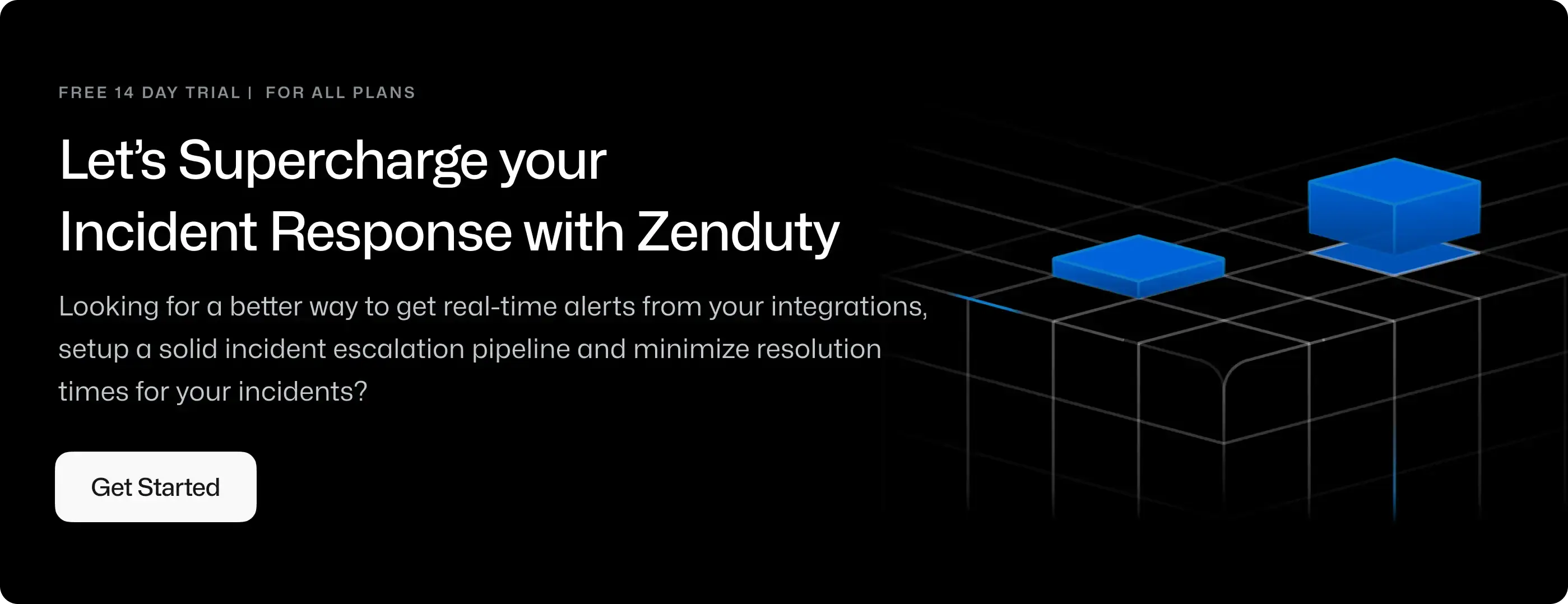AppDynamics Integration Guide
AppDynamics helps you monitor applications, infrastructure, and servers in one platform and provides real-time insights and transform your app performance with our Application Performance Management to drive business outcomes.
What can Zenduty do for AppDynamics users?
With AppDynamics's Integration, Zenduty sends new AppDynamics alerts to the right team and notifies them based on on-call schedules via email, text messages(SMS), phone calls(Voice), Slack, Microsoft Teams and iOS & Android push notifications, and escalates alerts until the alert is acknowledged or closed. Zenduty provides your NOC, SRE and application engineers with detailed context around the AppDynamics alert along with playbooks and a complete incident command framework to triage, remediate and resolve incidents with speed.
Whenever AppDynamics triggers an alert based on a predefined condition, Zenduty will create an incident. When that condition goes back to normal levels, Zenduty will auto-resolve the incident.
You can also use Alert Rules to custom route specific AppDynamics alerts to specific users, teams or escalation policies, write suppression rules, auto add notes, responders and incident tasks.
To integrate AppDynamics with Zenduty, complete the following steps:
In Zenduty:
-
To add a new AppDynamics integration, go to Teams on Zenduty and click on the team you want to add the integration to.
-
Next, go to Services and click on the relevant Service.
-
Go to Integrations and then Add New Integration. Give it a name and select the application AppDynamics from the dropdown menu.
-
Go to Configure under your integrations and copy the Webhook URL generated.
In AppDynamics:
-
Log into AppDynamics.
-
Navigate to the Alert & Respond then navigate to HTTP Request Templates and then click on New.



-
Provide a name to the template, say Zenduty alerts.
-
In the Request URL section, set the HTTP method to POST.
-
Paste the URL that you copied in step 4 in the Raw URL input box.

-
No custom headers are required.
-
In the Payload section, select the MIME type as application/json. Keep the payload encoding as UTF-8. In the payload box, paste the text below:
{ "severity":"${latestEvent.severity}", "event_id":"${latestEvent.incident.id}", "event_message":"${event.eventMessage}", "summary_message":"${latestEvent.summaryMessage} \n Link: ${latestEvent.deepLink}", "incident_key": "${latestEvent.node.name} - ${latestEvent.application.name}", "description": "${latestEvent.displayName}", "client": "AppDynamics", "client_url": "${controllerUrl}", "details": { "event_name": "${latestEvent.displayName}", "event_summary": "${latestEvent.summaryMessage}", "event_id": "${latestEvent.id}", "event_guid": "${latestEvent.guid}", "event_time": "${latestEvent.eventTime}", "event_type": "${latestEvent.eventType}", "event_type_key": "${latestEvent.eventTypeKey}", "application_name": "${latestEvent.application.name}", "node_name": "${latestEvent.node.name}", "message": "${latestEvent.eventMessage}", "severity": "${latestEvent.severity}" }, "contexts":[ { "type": "image", "src": "${latestEvent.severityImage.deepLink}", "alt": "${latestEvent.severity}" }, { "type": "link", "href": "${latestEvent.deepLink}", "text": "View this transaction in AppDynamics" } ] }
-
In the Response Handling Criteria section set the Failure Criteria status code to 400 and the Success Criteria status code to 201.

-
At the bottom of the page, click on Save. Your template is saved. To test the alert templace, right click on the newly created template, click on Edit. Navigate to the botton and click on Test. Select an Event Type Trigger with a count of 1 and click on Run Test.



- Go back to your Zenduty dashboard. An incident will be created with the test alert.
- Your Appdynamics Zenduty integration is now complete.
